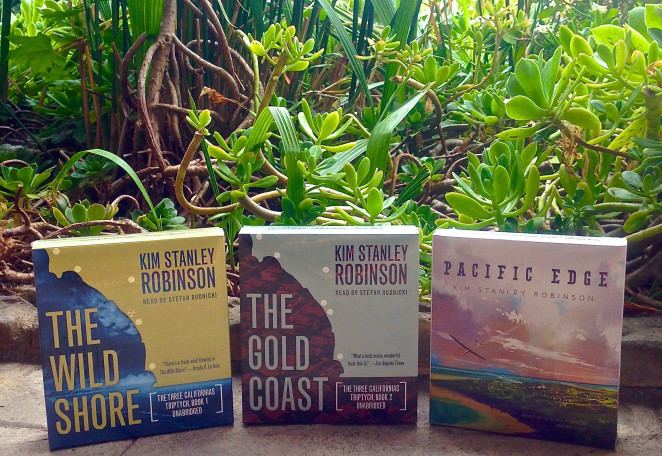Number of books 3 | ||
 | ||
Books The Wild Shore, The Gold Coast, Pacific edge | ||
The Three Californias Trilogy (also known as the Wild Shore Triptych and the Orange County Trilogy) consists of three books by Kim Stanley Robinson, that depict three different possible futures of Orange County, California. The three books that make up the trilogy are The Wild Shore, The Gold Coast and Pacific Edge. Each of these books describes the life of young people in the three very different near-futures. All three novels begin with an excavation which tells the reader about the world they are entering.
Contents
The Wild Shore
The Wild Shore was Robinson's first published novel. The Wild Shore (1984) is the story of survivors of a nuclear war. The nuclear strike was 2,000 to 3,000 neutron bombs that were detonated in 2,000 of America's biggest cities in 1987. Survivors have started over, forming little villages and living from agriculture and the sea. The theme of the first chapters is that of a quite normal science fiction pastoral, which is deconstructed in the latter chapters, especially when it becomes clear that the post-nuclear war rural life is hindered from developing further by international treaties imposed by the victorious U.S.S.R., with an unwilling Japan charged with patrolling the West Coast. The Wild Shore was nominated for both the Nebula and Philip K. Dick Awards in 1984. Algis Budrys described it as "a frontier novel, with rich threads of Steinbeckian populism woven into its cast of characters." Although faulting the novel's "failure to sustain the weight of its undertakings," he concluded that Wild Shore was "a remarkably powerful piece of work, still a good book, almost without doubt a harbinger of great books to come from Robinson."
The Gold Coast
In The Gold Coast (1988) we learn about the Southern California of 2027, a dystopian extension of today's Los Angeles and car-oriented architecture, mobility and life-style: "an endless sprawl of condos, freeways and malls." The book describes the life of 27-year-old Jim McPherson, who finds himself caught up in literary and academic interests, anti-weapons-industry terrorism, drugs, parties and casual sex. The Gold Coast was nominated for the Campbell, Locus, and British Science Fiction award in 1989.
Pacific Edge
Pacific Edge (1990) can be compared to Ernest Callenbach's Ecotopia, and also to Ursula K. Le Guin's The Dispossessed. This book's Californian future is set in El Modena, California in 2065. It depicts a realistic utopia as it describes a possible transformation process from our present to an ecologically sane future. The book does not assume a blank slate from which ecological utopia can be erected, but assumes the buildings, cities and infrastructures of our past and present. An important aspect of the book is the way these are changed to become "green". Pacific Edge is also realistic insofar as conflicts about diverging interests play a big role. In 2065, these are mainly conflicts between Greens and New Federals as the main political parties that are the A.A.M.T. using small companies to buy the last piece of wilderness in the area and develop it; but also conflicts on the personal scale, for example, Kevin, the main character builds a romantic relationship with the mayor's former lover. From a literary critique point of view the broad descriptions of nature and landscape are of interest, as well as the self-references in regard to writing about utopian futures versus actual political work. Pacific Edge was the winner of the John W. Campbell Memorial Award in 1991.
These books, especially Pacific Edge, can be seen as forerunners to Robinson's Mars trilogy.
Development history
In an interview with UCSD, Robinson said that "this was one of my few original ideas." And he came up with the idea for the novels while still at UCSD on a drive from UCSD to Orange County, California to visit his parents.
